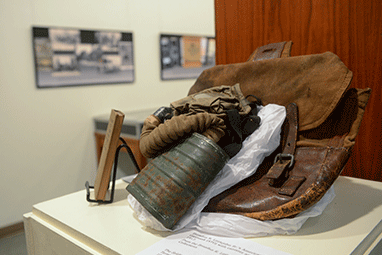SPARTANBURG, S.C. – Four-hundred-fourteen men from the Wofford College family served in the Great War, World War I. Seventeen did not come home.
The 414 – especially the lost 17 – are remembered in “WWI: At Home and Abroad,” an exhibition of artifacts from “the war to end all wars” (1914-1918), on display in the Sandor Teszler Library Gallery on campus. The exhibition, located on the lower level of the library, runs through Monday, Dec. 18. It is free and open to the public; gallery hours are Monday-Thursday, 8 a.m.-midnight; Friday, 8 a.m.-7 p.m.; Saturday, 10 a.m.-5 p.m.; Sunday, 1 p.m.-midnight.
The exhibition, marking the centennial of America’s entry into World War I, features unique items from Wofford’s Archives and Special Collections that illustrate the global and local impact of the war. Included are pictures of the Wofford students who made the ultimate sacrifice, letters of condolence written by the college president at the time, artifacts from a Wofford soldier’s kit and postcards from men serving in France. These items are coupled with a traveling exhibition that illuminates the political, social and cultural climate during that time. The traveling exhibition was produced by the library at Sewanee: The University of the South and funded by the Associated Colleges of the South.
Blue panels in the traveling exhibition tell a story of what life was like for Germans in America when President Woodrow Wilson declared war on April 6, 1917. It was the culmination of a time when anti-German sentiment already was pervasive in the United States. Anti-German propaganda targeted the large population of German-Americans living in the U.S., some whose families had settled here in the 1700s and who fondly celebrated their deeply rooted German traditions. The omnipresence of German heritage led to the unfounded belief that rampant German espionage put Americans at even greater risk.
Wofford graduate Gerald D. Sanders served during La Grande Guerre, and he lived and went on to write poetry, earn his Ph.D. and teach English to undergraduates in Michigan. Images from the Wofford College Journal literary magazine in the exhibit show samples of Sanders’ work published both while he was a student and after he graduated. One of his poems, written “somewhere in France,” portrays a deep sense of survivor’s guilt and a heart-wrenching wish to be with his fallen wartime friends still.
Another survivor of the war, Broadus R. Littlejohn Sr., the father of the namesake of Wofford’s treasured Littlejohn Collection, arrived in Valdohon, France, to train at the artillery school. The uniform he wore, his pack, his terrifying gas mask and primary documents relating to his time in the war are on display in the exhibit. A graduate of Wofford’s Fitting School, Littlejohn was discharged in June 1919 and came home to Spartanburg to start a business, the Community Cash grocery stores.
Looking closely at Littlejohn’s uniform, a visitor to the exhibit can see how worn the knees are and where he sewed tiny holes closed with his meticulous solder’s hands. Another piece of his belongings, though – the gas mask – reveals a less mundane element of war; if the eyes are the windows to the soul, these wide glass eyes hide depths unimaginable to most of us.
Gen. James C. Dozier, whose portrait from Wofford’s collection is in the exhibit, was a first-year student at Wofford (1915-1916) when he took the call to join the Army. Two years later, he found himself wounded near Montbrehain, France, yet he somehow was able to lead his platoon to safety while under machine gun fire.
In January of 1919, for his bravery, Gen. John J. “Black Jack” Pershing, commander of the Expeditionary Force on the Western Front, awarded Dozier the Medal of Honor. A first lieutenant in Company G, 118th Infantry, 30th Division of the Allied Expeditionary Force, Dozier later would be named South Carolina’s adjutant general, a position he held from 1926 to 1959. Dozier never returned to his studies at Wofford.
Also in the exhibition is a postcard collection that features images of agony and happiness, of destruction and romanticized war. Their messages are equally diverse, from the matter-of-fact to words of love and friendship.
Other words, sent from home on the unspeakably sorrowful occasion of the death of Wofford students in the war, live on in the archives. With sadness “beyond expression,” Wofford President Henry Nelson Snyder composed each of 17 letters of condolence, sent to the families of Wofford students who made the ultimate sacrifice and never came home. In the exhibition are the faces of those 17 Wofford men, and visitors may read the names of all 414 of Wofford’s own who served in the Great War.
For more information about the “WWI: At Home and Abroad” exhibition go to http://libguides.wofford.edu/librarygallery.
‘WWI: At Home and Abroad’ exhibition remembers Wofford men who served
Exhibit in Sandor Teszler Library Gallery includes artifacts, postcards and letters of condolence
Among the artifacts in the “WWI: At Home and Abroad” exhibition at Wofford College is the gas mask issued to Wofford Fitting School graduate Broadus R. Littlejohn Sr., who served in Valdohon, France. (Wofford College/Mark Olencki)
2017-10-20